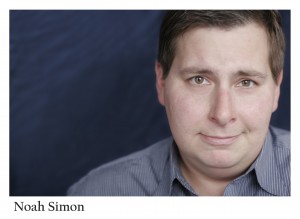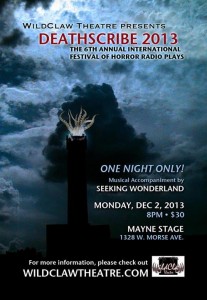Today we’re sitting down with Noah Simon, director of Jake Carr‘s Cheap Plastic Mask. Noah has been acting on Chicago’s stages since 1997. In that time he’s worked with Goodman Theatre, A Red Orchid, The Hypocrites, Defiant, American Theatre Company, and Strawdog Theatre Co., among many others. He is currently an ensemble member of Lakeside Shakespeare Theatre, and is a voiceover artist as well. He holds a BA in Theatre from Butler University and recently completed his MFA in Acting at The Theatre School at Depaul University. Noah is currently performing in Red Orchid‘s hit comedy, “Trevor“ (directed by “The Shadow Over Innsmouth“‘s own Shade Murray), and will tell us about using the unknown, raising tension, and What Scares Him.
How did you get into horror?
Horror films have always symbolized two things for me. Number one is the adrenaline rush of feeling scared. And the second is a stimulation of my imagination. I love when horror evokes a “this could really happen” response in me.
What excites you most about directing horror, compared to other genres?
Horror is so dependent on tone, pace and the resulting tension that it’s almost like directing a piece of symphonic music.
What in this script resonated most with you?
Things are scariest when you can’t see them. Sight helps us to categorize the things we see, which in turn helps our logical mind to make sense of something that inherently makes no sense. It’s a survival response. But when you can only hear something that is frightening, your imagination takes over and fills in the gaps in your sensory awareness, making whatever is frightening you, exponentially more frightening. Cheap Plastic Mask, while beginning in a benign way with a relatable event, lulls us into a false sense of safety, until something that the characters can’t see, but can hear begins to bring a darker reality into full focus, and leaves them vulnerable to their own imaginations.
What do you consider the biggest challenge in directing for “radio,” compared to traditional theatre?
If the audience could only hear our presentation and not see actors and Foley artists bringing the piece to life, I think it would be easier to accomplish whatever artistic goals we set for ourselves with regard to attempting to frighten them. But since they can see the actors, it becomes less about the story and more about watching people perform. I’m not suggesting that we can’t instill fear in this style of storytelling, but it does become harder.
What discoveries have you made about storytelling during this process that you are excited to use in future projects?
This is another chance to discover different methods of building tension, but that’s what I set out to do any time I direct. This is just a super challenging way to go about it.
What sound would you most like to see/hear performed in a Deathscribe piece?
What scares you?
Anything horror-related that could happen in real life, from ghosts to demonic possession. And murder. Murder scares the shit out of me.


